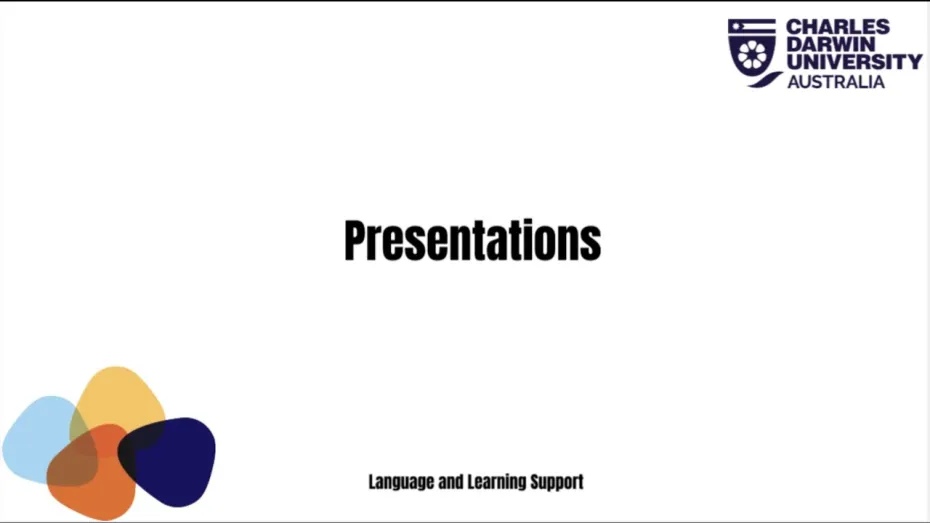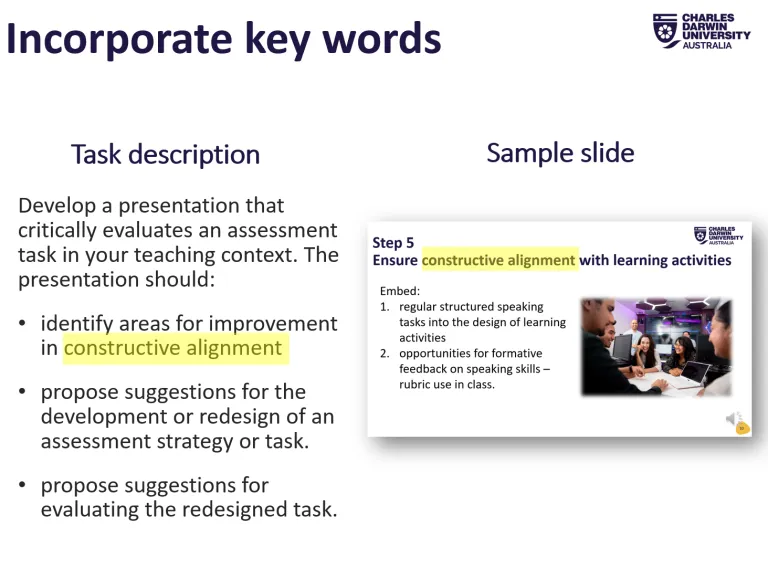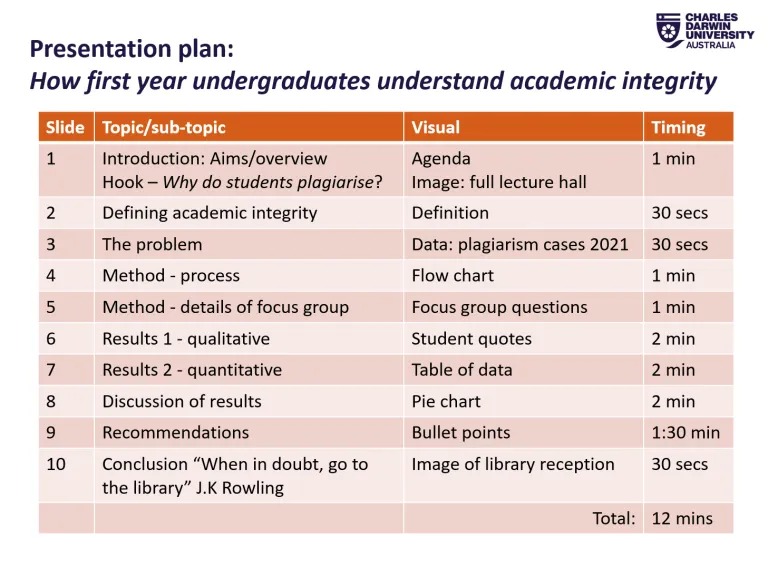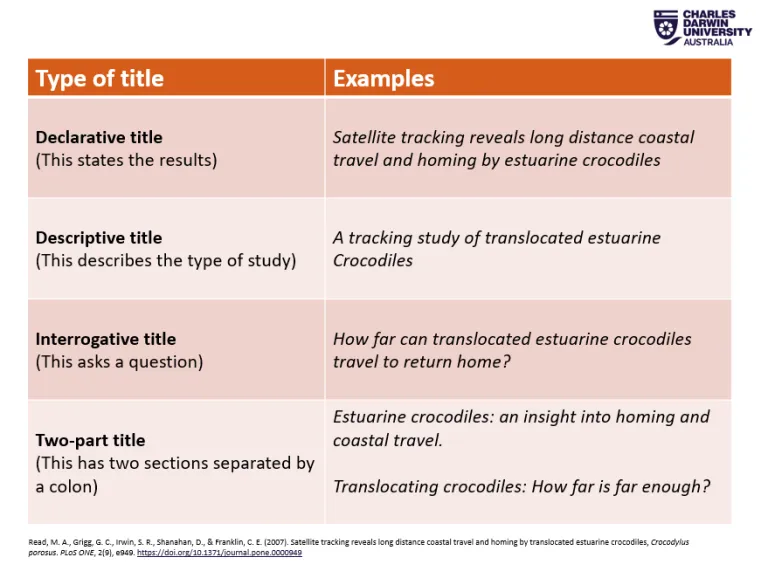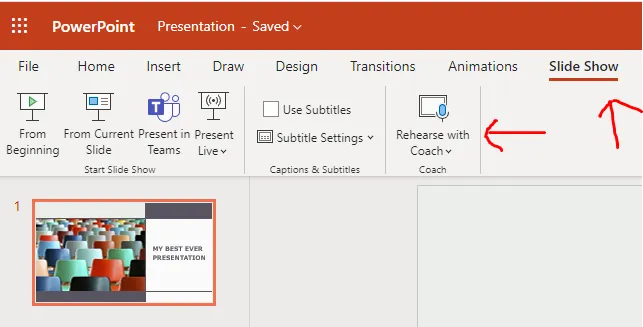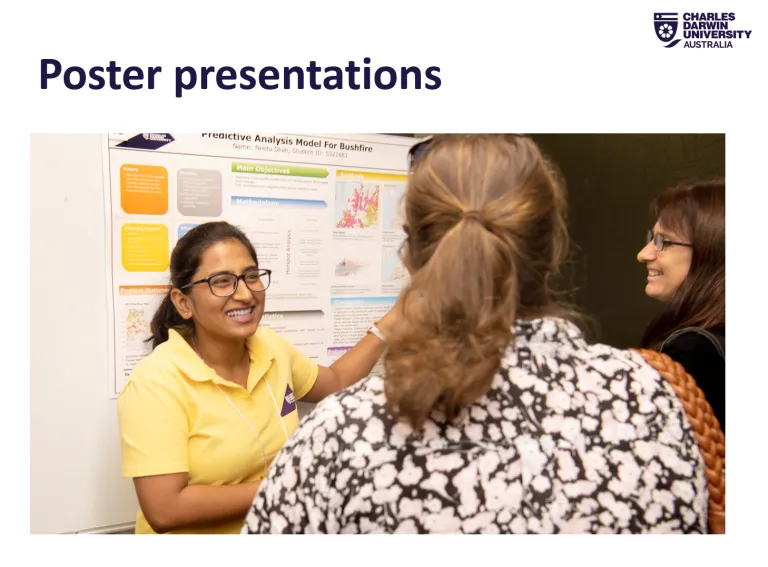One of the most common types of assessment at university is presentations. Presentations at university prepare you for life after graduation when your professional communication skills will be invaluable. These materials will help you prepare, design and deliver an informative and audience-friendly presentation.
This page will help you to meet your lecturers' expectations by:
- self-evaluating your current strengths and weaknesses
- planning and organising your presentation
- handling questions
- engaging your audience
- using clear spoken English
- creating effective visuals, slides and posters
- managing group presentations
- managing nervousness
- recording your presentations.
Download this summary sheet for your own reference.
Introduction to oral presentations
This section gives a general overview of presentations.
Self evaluation
Before you continue, reflect on your previous public speaking experiences and the feedback you have received. How would you rate your ability in the following skills? Rate your ability from ‘good’ to ‘needs development’.
Reflect on your answers. Congratulations if you feel confident about your skills. You may find it helpful to review the materials on this page to confirm your knowledge and possibly learn more. Don't worry if you don't feel confident. Work through these materials to build your skills.
Speaking at university
Spoken tasks are very common at university. Besides oral presentations, how many other types of speaking tasks do you think you may do?
Compare your ideas with these:
The materials on this page focus on presentations, but the tips and strategies are useful for a range of speaking tasks.
An overview of presentations
A successful presentation is designed to meet the needs of the audience. Think about this. While attending your presentation, the audience needs to:
listen to your voice; i.e., your pronunciation, language choices and style of delivery
understand the information conveyed by your voice
read the text and the visuals on your slides
understand the information conveyed by the text and visuals
watch your face and gestures
understand the messages conveyed by your face and gestures.
The audience must do all these things simultaneously. This is a heavy cognitive load, so your job is to make it as easy as possible for them.
Watch this video for a general introduction to presentations.
Now, check your understanding.
A process for preparing your presentation
This section will take you through the stages of preparing your presentations.
Step 1: Understand the task
1. Read the task instructions carefully to understand requirements.
When will you deliver the presentation?
Is it individual or group?
Is it online or face-to-face?
Is it recorded or live?
How long is it?
Is a question-and-answer session included?
How will you be assessed?
2. Analyse the task to identify the topic and scope.
Revise how to analyse a task in the Study Skills page Preparing for the essay.
Highlight key words in the task and ensure you use them in the presentation.
Step 2: Consider the audience
3. Consider the needs of your audience by answering these questions:
What does the audience already know about the topic?
What do they need to know?
What is most likely to interest them?
Consider the audience in each of the following situations and decide which presentation element is likely to be the LEAST useful or interesting for them.
Step 3: Prepare your content
4. Do your research.
Visit the Subject Guides on the library page for research tips tailored to your discipline.
Check the Library workshop calendar for workshops revising research skills.
5. Organise your content.
Sequence your content into logical order
Create a presentation plan
Read this example presentation plan. Would this be a useful method for you?
Notice how this student divides their content into topics and sub-topics, puts it into a logical sequence, and decides on the number of slides each topic is likely to need (columns 1 and 2). They then plan potential content for the slides and estimate the amount of time they will spend on each topic (columns 3 and 4).
Remember: a presentation plan will help you to get organised but it is a working document that may change as you learn more about your topic.
Step 4: Prepare for delivery
6. Create your slides and presentation notes.
A. See Effective visuals below for advice on designing slides.
B. Decide on the most useful type of notes for you. Ideas include:
|
7. Practise your delivery.
This material contains a lot of advice on ways you can practise. Work through the rest of the page to learn more strategies.
Organisation and transitions
This section will provide an overview of the stages of a presentation and transitions between sections.
An overview
In Introduction to oral presentations, you learned that presentations usually have three stages: introduction, body and conclusion.
The amount of time you should spend on the introduction, body, and conclusion of your presentation can vary depending on the length of your presentation, the complexity of your topic, and your personal presentation style. However, as a general guideline, you could aim to allocate your time in the following way:
Introduction | 10-20% | Tell them what you are going to tell them. A strong introduction should capture your audience's attention and provide a clear overview of what you will be discussing. |
Body | 70-80% | Tell them. This is the main part of your presentation where you will go into detail about your topic and present your arguments and evidence. |
Conclusion | 10-20% | Tell them what you told them. A strong conclusion should summarise the main points, restate your key message, and leave a lasting impression on your audience. |
Remember that these percentages are guidelines, not rules. Your timing may vary so it is important to create a presentation plan and rehearse to ensure you use your time well to effectively communicate your message.
Introductions
Audiences form their first impression of a speaker within 90 seconds (Wallwork, 2016), so it is important that you introduce yourself with confidence. However, at the start of your presentation, you may be feeling unsettled. If you are nervous about public speaking, plan a simple, well-structured introduction that follows the steps below. By the time you have delivered this information, you may begin to overcome your nerves.
Your introduction should include some or all of the following. You could:
greet the audience and introduce yourself
introduce the topic and aim
give your scope, or specific points on which you will focus
give an outline of your presentation
announce when the audience can ask questions.
use a hook to engage the audience
Read these two presentation introductions to:
identify the stages of an introduction – click on the hotspots to check your ideas
consider how the presentations are similar and different.
These two presentations are about the same topic, but they are different in their approach. Presentation one is more traditional, while presentation two has a more conversational tone and uses more hooks to engage the audience. Both presentations are strong, clear and succinct. In planning your presentation, you should create your own approach that:
meets the needs, interests and expectations of your audience
you feel most confident with.
Read these sentences and place them to create a cohesive introduction.
Language in introductions
If you are studying in your second or third language, you may occasionally stumble over collocations (words that usually go together). This exercise is to help you to review common collocations used in introductions.
The body and transitions
Just as your essays are divided into paragraphs that present ideas in a logical order, so should your presentation be divided into logical sections.
You need to signal very carefully to your audience when you are linking ideas and when you are transitioning from one section to the next. To manage a transition, you could try one or more of the following ideas.
- Give a brief recap of the main message of the section you just completed (in long presentations).
- Pause for a couple of seconds at the end of each section to give your audience a chance to process the information you have given them.
- Use a divider slide that announces the next part of your talk.
- Use signpost language: phrases that signal transitions and links between ideas.
Signpost language serves an important purpose. Used badly, these phrases can sound stilted and formulaic; however, used well, they help your audience follow your logic, and they help you manage your delivery.
Conclusions
Conclusions are an essential part of your presentation because they are a last chance to convey your most important message and to create a lasting impression on your audience.
Your conclusion should include some or all of the following. You could:
signal that your presentation is concluding
include a summary or overview of your talk
reiterate the takeaway message, or what you MOST want your audience to remember
use a final hook to make a lasting impression on your audience
introduce question time.
Read these two presentation conclusions to:
identify the stages of the conclusions – click on the hotspots to check your ideas
consider how the two presentations are similar and different.
These two conclusions are about the same topic, but they are different in their approach. Conclusion one is more traditional, while conclusion two is more conversational and actively tries to engage the audience. In planning your own presentation, you should create your own approach that:
meets the needs, interests and expectations of your audience
you feel most confident with.
Questions at presentations and lectures
This section will provide an overview of how you can effectively ask and answer questions.
Asking questions
You may not have given much thought to how you ask questions during presentations or lectures. However, it is important that you can do this well.
Keep these tips in mind:
- If you have a question during a lecture or a conference presentation, don’t be shy to ask. Remember: not only do questions help you to learn, but they can also help you get noticed as an engaged student.
- If the presentation is long, note your questions as you think of them. The question may be answered later in the presentation, but if it isn’t, your notes will help you remember them during question time.
- At the end of long presentations, you should contextualise your question to make it easier to answer. This is explained next.
If a presentation is long, you may need to ask a question about information that was delivered 30 or so minutes previously. Therefore, you may need to identify which part of the presentation you are referring to.
Divide your question into three parts:
| Context | Tell the speaker which section of the presentation you are referring to. |
|---|---|
| Focus | Tell the speaker which specific element you are unsure about. |
| Clarification | Tell the speaker what you want to know. |
If you are studying in your second or third language, you may occasionally stumble over collocations (words that usually go together). This exercise is to help you to review:
the three stages of a question
common collocations used in questions.
Preparing to answer questions
The first thing you must remember is that questions at your presentations are a very positive sign. They tell you that your audience has listened, and they are interested enough to want to know more. Nevertheless, question time can make many students feel nervous. However, if you prepare well, you can feel more confident that you can handle this stage of your presentation.
Answering challenging questions
Despite preparing thoroughly, you may sometimes be asked challenging questions that you either don’t quite understand or you are not sure how to answer. Try these strategies.
1. Clarify questions that you don’t understand by asking the questioner:
to stand or speak up if you can’t hear them in a live presentation
to rephrase if you think you are misunderstanding them
questions to clarify what they want to know.
2. Gain a couple of seconds of thinking time by:
commenting on the question
repeating or paraphrasing the question.
3. Refer the question on to:
an appropriate peer in a group presentation - if the question is outside your area
the audience - if the question seems to be more open-ended or hypothetical.
Engaging the audience
This section will review strategies to engage and maintain your audience’s attention.
Titles
Engaging your audience can begin before you start your presentation. In fact, it begins when you write your title. A title has two goals:
- To convey the main message of the presentation
- To attract the widest possible audience.
If you are doing a presentation for one of your units, writing the title might seem relatively simple. Your lecturer may even suggest a title. However, if you are participating in an event, you need to write your title more carefully. At many events, the audience chooses which presentations they will attend or which poster presenters they will stop and listen to. For this reason, you need to create an effective but interesting title that will engage the audience at that event.
If you are doing a presentation based on a written assignment or paper, you may rewrite the title for the presentation. This is the title of a paper published by Read et al (2007).
Satellite Tracking Reveals Long Distance Coastal Travel and Homing by Translocated Estuarine Crocodiles, Crocodylus porosus
Read these presentation title suggestions. Which do you prefer?
Over to you:
1. Reread the instructions for your presentation task. Consider these questions:
- What guidelines have you been given for the title?
- Who are the audience and what is likely to interest and engage them?
2. Write a declarative, a descriptive, an interrogative and a two-part title.
3. Ask a peer to read each and give feedback on the most engaging and informative.
Hooks
Effective presenters use a range of techniques to catch and keep the interest of their audience. These are sometimes called hooks.
Compare these two introductions.
| 1 | Hello. My name is Kim, and my thesis presentation is about the use of bamboo in construction. First, I will give some general background, identify my issue and explain why it is important. Second, I will… |
| 2 | Hello. My name is Kim. Before I begin, I’d like you to discuss this question with the person next to you. Historically speaking, what do you think has been the most common material used in construction scaffolding in Asia? … [pause for discussion] ... Many Australians are surprised to learn that it is bamboo. In fact, it surprised me when I first arrived in Australia to learn that bamboo was rarely ever used here. This is why the topic of my thesis is… First, I will… Then, I will... |
Both introductions are competent, but in the second introduction, Kim hooks the audience with a discussion point. This gets the audience’s attention and increases their curiosity about her topic. You can hook and maintain the audience’s attention in many different ways and at any time during your presentation.
Match these hooks and examples below:
Keep in mind that your audience’s attention may drop during a long presentation, so you can help them focus and follow you by:
spending no more than approximately one or two minutes on each slide
giving or repeating important information when attention is high: the beginning, the end, and after a hook
using a hook when you feel the energy in the room drop.
Body language
A large proportion of communication is non-verbal, so your voice and body language are an important part of your presentation. They can create a positive or negative impression on your audience.
Think about these guidelines. What advice is useful for you?
Remember the general guidelines above, but also remember that body language can depend on the presenter’s personality and cultural background.
Don’t try to force yourself to behave in ways that make you uncomfortable. Remember that your body language will be more engaging if you:
feel relaxed and well-prepared
allow your own interest in the topic to show.
The use of voice
Your voice is critical in oral presentations because it is the primary tool you use to convey your message to your audience. Think of your voice as your instrument. How you use it affects how your audience perceives your message.
Reflect on the public speakers you enjoy listening to and find easy to understand. They could be well-known speakers, like a political figure, or less well-known, like a lecturer.
Why do you enjoy listening to them?
What do they do that helps you understand them easily?
Listen to these two extracts.
Which do you think is most effective?
Why?
Many listeners would find speaker B more engaging and easier to understand because the speaker uses a good pace, pausing, clear stress and appropriate intonation.
Pace is the speed of our speech.
The average speed is about 125-150 words per minute, but this varies depending on age, gender, culture and situation.
Many public speakers slow their pace slightly so their audience can follow their ideas.
Pausing is a brief stop when we speak.
Speakers naturally pause to draw breath.
Good public speakers use brief pauses to give their audience time to absorb their message.
Intonation is how our voice rises and falls when we speak.
A rising voice creates anticipation. It indicates that another point is coming.
A falling voice creates a sense of importance. It also indicates that you’re finishing a point.
Stress is when we say some words more loudly than others.
Stress is put onto the main content words – or words that carry the main message
Stress is put onto certain words for emphasis to draw attention to a point.
Let’s now explore in more detail how these techniques are used in a presentation.
Top tip:
You can find online support to practise your use of voice through a range of apps and software. One example that you can access through your student Microsoft account is Speaker Coach.
Repetition and the rule of three
Repetition and the rule of three are two more techniques you can use to make your presentation more engaging.
Repetition
We hear repetition frequently in speeches. Read these examples in famous political speeches:
Although you may not be a political figure (yet), you may occasionally use some repetition in your presentations. Repetition is used for:
| Emphasis: | Repeating key phrases/ideas tells the audience they are important. |
| Memorability: | Repeating key phrases/ideas helps the audience to remember the main points. |
| Rhythm: | Repeating key phrases/ideas helps to create a sense of rhythm and anticipation. |
What would you repeat in these sentences?
Practice these sentences by repeating them aloud.
The rule of three
The rule of three is a technique in which we present information in groups of three.
Think about how the rule of three is used in different situations:
Giving ideas in groups of three is not a strict rule; however, it is a useful strategy because it is:
| Memorable: | Our brains seem to be able to remember groups of three items more easily. |
| Satisfying: | Groups of three seem to create a sense of completeness in the listener. |
| Concise: | Three items seem to emphasise a message without overwhelming your audience with too much information. |
1. Explore how these techniques are used in an authentic presentation.
2. Download the script of the talk below. Read and make notes while you listen again.
3. Download the annotated script and compare your answers.
Over to you:
1. Can you finish this sentence using the power of three?
To deliver an effective presentation, I need...
2. Think about a presentation you need to deliver soon.
Script your introduction, including either repetition or a group of three items.
Mark your stress and intonation.
Ask a peer to listen to you deliver it and give you feedback.
Written vs spoken English
Many presentations at university are based on a written assignment. This section will help you adapt your written text to oral English.
Oral English
When you are preparing a presentation based on a written paper, you may feel tempted to read sections of your paper aloud – especially if the presentation is recorded or online and your audience can’t actually see you. DON’T do this.
- Compare these two texts. Which one is spoken English?
- Move the slider to reveal an analysis of the language
This analysis illustrates an important point: compared to spoken English, written academic English usually:
uses more formal, academic vocabulary
uses more nouns, especially nominalisations
has fewer but longer sentences
is more dense; that is, it contains more detail in fewer words.
Therefore, reading aloud from your paper sounds unnatural, makes your presentation less engaging and makes your information harder for your audience to follow.
Top tip: when you are preparing an oral presentation based on a written text, you should create your presentation from a plan, not from the text. To do this, you could:
- read through your written text, and for each paragraph, write key words into a separate document
- use the key words to make a presentation plan
- practise delivering your talk from the key words; if you forget some elements, add extra notes
- transfer your notes to one of the following:
note cards for each stage of your talk
a printout of your slides
a list of key ideas and facts in bullet points
a tree-diagram or flowchart of the structure of the talk
5. practise delivering your talk using your notes, not the original assignment.
Talking about figures
Another point to consider when you are preparing a presentation based on an assignment is how you will handle the data and statistics. Many of these are conveyed through visuals, such as tables and graphs; however, you still need to explain your figures. To do this, you must consider how you will say them.
Listen to these extracts and consider how clear the figures are.
Remember:
- Use percentages when you can because they are usually easier for audiences to remember.
- Use smaller figures when you can because they are usually easier for listeners to comprehend.
- Reduce the number of figures you recite.
- Support figures with words and phrases like rise or fall, majority or minority, or trend
- Avoid difficult combinations of sounds and pay special attention to numbers that end in -teen or -ty.
Top tips:
When you are preparing an oral presentation based on a written text that includes numbers, try these ideas.
- Ask a peer to listen to your talk and write down the numbers they hear. If any are incorrect, consider how you can make them clearer for the listener.
- Ensure that important figures you need to say are also written on your slides.
Avoiding jargon
In Engaging the audience, you learned about avoiding highly technical words in your titles to attract a wide audience. This also applies in the body of your presentation, especially if your audience is multi-disciplinary (or including people from a range of disciplines besides yours).
Just as you consider audience and purpose in your writing, you must do the same when preparing your oral presentations.
Read the following two sentences. Which would you say to multi-disciplinary listeners?
Stem cell malfunction is caused by DNA damage produced by reactive oxygen species.
DNA damage-induced HSPC malfunction depends on ROS accumulation downstream of IFN-1 signaling and bid mobilisation
Most people would agree that sentence one would be appropriate for an audience with people from outside your discipline.
Top Tip:
If your audience is multi-disciplinary, ensure you provide definitions or examples to explain necessary technical words. Images on your slides are also useful.
Effective visuals – slides and posters
This section will give you tips for creating effective slides or posters.
Visual design
Design is a broad but interesting field that you might like to explore if you need to produce many visuals in your future studies or your profession. For now, these tips will introduce you to basic principles to help you get started on your first slides and posters.
Examine each slide to determine the design problem. Then click to the next slides for a useful tip.
Over to you:
Examine slides you are drafting for your own presentation. Have you avoided these issues?
Posters
A poster presentation at a conference is a session where researchers present their work on a poster. A poster is a visual display of the researcher's work, including text, graphs, images, and tables.
During the presentation session, the researcher stands by their poster and explains their work to conference attendees who walk around the room viewing the posters. This is the major difference between regular conference presentations and poster presentations: conference presentations attract an audience with a well-written abstract; however, posters attract an audience by being eye-catching, visually pleasing, legible and informative.
The design elements that you must consider are the same as those outlined above for slides. However, you must also consider that the audience needs to be able to read the poster from at least 1.5m away
Compare these two posters. Move the slider left and right so you can compare different elements.
Here are some key poster characteristics. Well-designed posters are:
| 1 | clear and legible | A good poster should be concise and clearly communicate the main message of the research. It should be easy to read and understand from a distance of about 1.5m.
|
| 2 | concise | An effective poster avoids unnecessary text by using bullet points and by minimising lengthy prose in dense paragraphs. Aim for 30 to 50% white space. |
| 2 | visually appealing | A well-designed poster should be visually appealing and grab the viewer's attention. Choose a colour palette of no more than three to five colours. |
| 3 | organized and logical | The flow of the poster should be easy to follow, with headings and subheadings that guide the viewer through the content. Remember, viewers from Western cultures read:
|
| 4 | supported with visuals | The use of visuals such as graphs, charts, and images can help to convey complex information in a simple and easy-to-understand way. |
| 5 | professional | The poster should look professional, be free from spelling and grammar errors, and have a consistent design. |
Designing a poster is easier if you use a template. Academic poster templates are freely available online
Over to you:
Examine a poster you are drafting for your own presentation. Have you avoided these issues?
Referring to visuals during your presentation
When you are delivering your presentation, you need to explain your visuals. You should not leave it to your audience to interpret the significance of your charts and graphs. They may not come to the conclusions you intend.
- Tell your audience you are going to show them a visual.
- Direct your audiences’ attention to the relevant part of the visual.
- Comment on the visual.
- Interpret the visual: explain results, discuss the significance, and/or link it to other data or research.
Managing group presentations
This section will offer tips for managing group presentations.
Preparing the group presentation
All of the advice on this page for preparing and delivering presentations applies to group work. However, you will have more to consider when you are working with others.
These tips can help you avoid some of the challenges.
Delivering group presentations
These tips can help you avoid some of the challenges of presenting as a group.
| Tip 1 | Introduce the whole group during the introduction. Decide if you will:
|
| Tip 2 | Ensure the transitions between members are smooth. As each member finishes their section, they should introduce the next speaker. Language for handing over to team members includes:
|
| Tip 3 | Have a plan for monitoring timing. You could:
|
Dealing with nerves
The author, Mark Twain, once said There are only two types of speakers in the world. 1. The nervous and 2. Liars. This section offers tips to help you manage your nerves.
Building resilience and skill
Many people feel nervous about speaking in front of a group of people, so you are not alone. However, you will do many presentations while you are a student, so you can build your resilience and skill over time.
Remember this:
- Feeling a bit nervous can be a positive thing. Think of nervous adrenaline as a superpower that sharpens your brain and brightens your performance.
- Your nervousness may not be obvious to the audience.
- Even if the audience can see that you are nervous, this often generates sympathy and goodwill in many listeners.
- Your audience at university is likely to be your peers and your teachers. These people want to help you and see you do well.
Reflect on these ideas for building your resilience. Which ones could you try?
Managing nerves before delivery: warming up
Just like we should warm up our muscles before exercising, we should warm up our face and voices before presenting. Warm up exercises help because they:
distract you from being nervous while you wait for your turn to speak
prepare you to speak freely and without stumbling.
Reflect on these ideas for managing nerves before delivery. Which ones could you try?
- On the day before, do some exercise to lower your levels of stress hormones.
- On the day, try these warm ups.
Here are some tongue twisters to try. Repeat each one five times.
Pitter patter Eddie edits Tittle tattle Unique New York Red leather yellow leather Good blood, bad blood, bad blood, good blood | Riley's riding wave runner one Double bubble gum bubbles double Eat fresh fried fish at the fish fry Sixty-six sick chicks A proper cup of coffee from a proper copper coffee pot. She sells seashells by the seashore. |
Managing nerves during delivery
Even with thorough preparation, we can be nervous on the day of our presentations.
Reflect on these strategies. Which ones might work for you?
Recording presentations
This section offers some tips for recorded workshops.
Preparing for recorded presentations
All of the advice on this page for preparing and delivering presentations applies to recorded presentations. However, you have some extra points to consider. These tips can help you avoid some of the challenges.
Making a recording
Your method for recording your presentation will depend on your assignment instructions and the tools you have available to you. If recording is new to you, ensure that you:
leave plenty of time to learn how to use the equipment and software
use the training offered by the software provider, so you know that the information is correct and up to date.
You may find these training videos useful:
Record a powerpoint slide show with narration
Record your screen in PowerPoint
How to record the screen on your Mac
You may like to explore these tools:
Screencastify is an extension for your Chrome browser that can record your screen.
Zoom is mostly for meetings, but you can record videos of yourself and your screen.
Oral presentations and generative AI
Generative artificial intelligence (GenAI) can be very helpful when preparing for oral presentations. It can help to understand and unpack the task, brainstorm ideas, summarise articles, and generate draft outlines. However, overreliance on AI-generated output can undermine the learning process and violate academic honesty policies.
The limitations of Gen AI for oral presentations
Oral presentations are considered more cheat-proof than other assessment types andGenAI has several limitations when used to prepare for them. Unlike written tasks, presentations can require spoken delivery to a live audience and presenters may be encouraged to engage the audience and answer questions. GenAI can generate coherent text and attractive images, but it cannot deliver a presentation for a student, nor can it transfer the kind of comprehensive understanding of a topic that is needed to stand up to meaningful engagement with an audience.
GenAI can be helpful in some parts of the process but cannot assist in other important aspects. Let’s look at its strengths and limitations. Answer the questions below.
Read this excerpt from an AI-generated presentation transcript and consider how well it addresses the criteria in the rubric. Then, compare it with a sample of human text.
Prompts to help you get started with your oral presentation
Prompt engineering is a pivotal skill in leveraging AI effectively for academic and professional purposes. Clear and specific prompts, such as those focusing on outlines or research plans rather than final products, foster deeper engagement with the subject matter and uphold academic integrity.
See below some prompts to help you get started with your next presentation.
We also encourage you to review our study skills page “Using AI tools at university” and download the GenAI Quick Tips sheet to learn more about how to use GenAI effectively and ethically.
Applying your learning
- Reflect on what you have learned in this material and consider how you can use it in your own work.
- Follow these tips to help you practise and improve.
Over to you
You can improve your own presentation skills by learning from experienced presenters.
Step 1
- Go to https://www.ted.com/talks and select a Ted Talk
- Watch for five minutes with the sound off.
- Note the speaker’s body language.
Where do they stand?
How do they move around?
What gestures do they use?
Where do they look around the room?
What facial expressions do you notice?
Step 2
- Go to https://www.ted.com/talks and select a Ted Talk
- Listen for five minutes with the screen covered.
- Note the speaker’s use of voice.
How quickly do they speak?
How often do they pause?
How well do they use stress and intonation?
Do they use other techniques like repetition or the power of three?
Keep in mind that TedTalks are not academic presentations; so, they may be more personal and less structured than your university presentations. However, they are a good tool for learning about body language and effective use of voice.
Step 3
- Rehearse your presentation with online support such as Speaker Coach.
- Prepare a presentation for one of your units.
- If you use your student microsoft account, go to Slide Show and select Rehearse with Coach.
- Use this feature to get advice on your delivery.
Step 4
- Prepare a presentation for one of your units.
- Record yourself delivering it.
- Exchange recordings with a peer and give each other feedback or
- Book a group room in your library and practise delivering to each other.
Next steps
Reflect on your learning.
1 | Revisit the self-analysis quiz at the top of the page. How would you rate your skills now? |
2 | Remember that learning is a process and mistakes aren't a bad thing. They are a normal part of life and can help you to improve. |
If you would like more support, visit the Language and Learning Advisors page.
We value your opinion. Please click on the button to share your feedback on these Essay materials. |
Did you know CDU Language and Learning Advisors offer a range of study support options?
https://www.cdu.edu.au/library/language-and-learning-support

